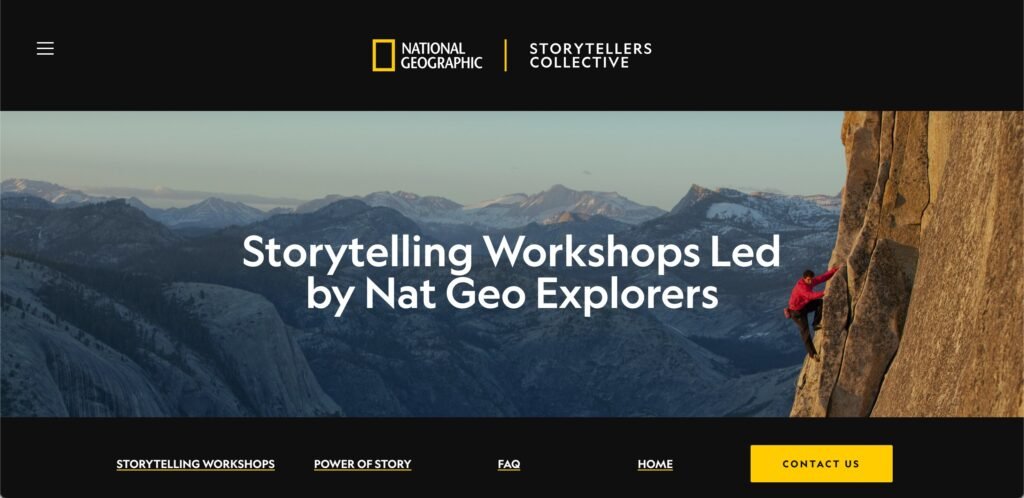To become a professional storyteller, you need to work on your storytelling skills. Practice often and connect with other storytellers. Try to share your stories on different platforms. Start by refining your craft through workshops and wide reading.
Attend events where you can learn and perform your stories. Develop your own unique style and portfolio. Look for chances to share your tales at festivals, on podcasts, or in communities. This experience will help you find your niche in the storytelling world.
I’ve always loved the impact of telling stories. It can hold people’s attention, stir their emotions, even change their lives. In this article, I’ll pass on tips to help you steer your love for tales into a career.
Improving your storytelling isn’t just about the tale; it’s how you share it. Regular practice, feedback, and learning new techniques are key. Getting good at storytelling takes time. Many pros make it their life’s work before they see success.
Being a storyteller offers a range of paths to follow. From traditional oral storytelling at events to podcasts, the options are endless. Storytellers find success in many places, including businesses, schools, and as freelancers.
Key Takeaways
- Develop strong storytelling skills through practice and study
- Explore various platforms like festivals, podcasts, and community events
- Network with other storytellers and industry professionals
- Create a unique storytelling style to stand out
- Consider specializing in a specific genre or audience
- Embrace technology and new media for storytelling
- Continuously seek feedback and opportunities for growth

The Power of Storytelling in Modern Communication
Storytelling changes how we see the world today. It makes difficult ideas easy to understand. I’ve learned that sharing stories is more than fun. It’s a way to deeply connect with others.
Connecting with Audiences Through Narrative
Sharing personal stories is like inviting others into our lives. It turns simple facts into something memorable. A good story can connect people from different backgrounds.
Storytelling’s Impact on Memory and Empathy
Stories are more than just words. They activate our brains and help us remember. When we tell stories, we engage people’s feelings and understanding, not just their minds.
The Role of Stories in Personal and Professional Growth
Telling stories has helped me in my career in many ways. It’s vital for leading, building brands, and improving how we talk. A story can move people to act, achieve goals, and make a change. This is why most customers prefer products with good stories about them.
| Benefit | Impact |
| Building Trust | Creates rapport with audience |
| Brand Differentiation | Sets apart from competitors |
| Memorable Content | Increases shareability |
| Engagement | Boosts loyalty rates |
| Sales Conversion | Drives revenue growth |
Storytelling has grown from old tales to today’s online stories. Yet, its essence hasn’t changed. It’s all about building connections that lead to understanding and personal growth. I love guiding others to shape their stories effectively.
Essential Skills for Becoming a Professional Storyteller
Being a skilled storyteller is not just about talent. It’s important to learn special skills and techniques. To be a pro, you need to master key abilities.
Here are the key competencies to focus on:
1. Strong Communication Skills
- Clarity and Conciseness: A good storyteller must convey their message clearly and succinctly, avoiding unnecessary details that could confuse the audience.
- Vocal Variety: Using different tones, pitches, and volumes can enhance the storytelling experience, making it more fascinating.
- Body Language: Effective use of gestures and facial expressions helps to reinforce the narrative and maintain audience interest.
2. Audience Awareness
- Know Your Audience: Understanding the demographics, preferences, & expectations of your audience allows you to tailor your stories for maximum impact.
- Empathy: Being able to relate to your audience’s feelings and experiences fosters a stronger connection and makes the storytelling more relevant.
3. Narrative Structure
- Understanding Story Elements: Mastering the components of a good story—characters, conflict, resolution, and moral—enables storytellers to craft compelling narratives that resonate with listeners.
- Creating a Hook: A strong opening captures attention and sets the tone for the story, encouraging the audience to stay engaged.
4. Adaptability
- Flexibility in Delivery: Great storytellers can adjust their stories based on real-time audience feedback, modifying tone, pacing, or even story elements to better suit the mood and reactions of the listeners.
- Improvisation: Being able to think on your feet and respond to unexpected situations or audience interactions is crucial for maintaining engagement.
5. Emotional Intelligence
- Vulnerability and Authenticity: Sharing personal experiences and emotions can make a deeper connection with the audience, making the storyteller more relatable and trustworthy.
- Empowering Others: Stories that inspire and motivate listeners can have a lasting impact, encouraging them to reflect on their own lives and aspirations.
6. Practice and Feedback
- Continuous Improvement: Regular practice and seeking constructive feedback from peers or mentors help storytellers refine their skills and techniques.
- Experimentation: Trying out different storytelling styles and formats can lead to discovering a unique voice and approach.
7. Networking and Marketing
- Building a Portfolio: Documenting and showcasing storytelling performances through videos or audio recordings can attract potential clients or audiences.
- Community Engagement: Joining storytelling groups or networks can provide support, resources, and opportunities to perform and collaborate with other storytellers.
By developing these skills and qualities, aspiring storytellers can enhance their craft & establish themselves as professionals in the field. Storytelling is not just about narrating events; it’s about creating connections, evoking emotions, and leaving a lasting impression on the audience.
Crafting Compelling Narratives: Techniques and Strategies
Composing a compelling narrative is at the core of storytelling. Personal stories that people can relate to are essential. This article will show you techniques for making your stories more meaningful.
Making Your Story Personal and Relatable
Start by looking at your own life for story ideas. Everyone loves a story they can connect with. Tell about something that deeply moved you or changed how you see things. This way, your story can touch the hearts of your listeners.
Structuring Your Story for Maximum Impact
A good storyline grabs attention and keeps it. Begin with an intriguing opener. Then, raise the tension as you go on. Finally, wrap it up in a way that feels complete. This method is a proven way to make a story stand out.
Using Pacing and Timing to Enhance Engagement
Effective storytelling involves mixing up the pace. Slow down when it gets intense. Speed up for the thrilling parts. Use breaks to emphasize key ideas. This dynamic approach will keep your listeners hooked throughout.
| Storytelling Element | Impact on Audience | Tips for Implementation |
| Personal Connection | Increases relatability | Share authentic experiences |
| Clear Structure | Enhances understanding | Use hook, build-up, resolution |
| Varied Pacing | Maintains engagement | Adjust speed for mood and emphasis |
Building Your Career as a Professional Storyteller
Starting out in storytelling takes hard work and being proactive. To be successful, it’s essential to look for chances and connect with others in the field. Now, let’s look at ways to kickstart your storytelling career.
Volunteer Opportunities and Networking
Volunteering helps you gain experience and make connections. Contact libraries, schools, and community centers to see if they need a storyteller. This is a great opportunity to get your name out there. Also, participating in story-circles helps you enhance your skills and meet other storytellers.
Creating Your Own Storytelling Platform
Don’t just sit around and wait – start something yourself! Initiating a storytelling club or event in your area is a great first step. You could also start a podcast or YouTube channel to share your tales. Remember to mix unpaid opportunities with paid ones as you get started.
Attending Storytelling Events and Festivals
Diving into the storytelling community can help you grow a lot. Go to storytelling festivals and workshops to learn from the pros and meet other storytellers. The National Storytelling Network lists events to help you locate those near you.
| Career Building Activity | Benefits |
| Volunteering | Gain experience, build connections |
| Creating a platform | Increase visibility, develop audience |
| Attending events | Learn from professionals, network |
Remember, sticking with it is crucial for your storytelling career. Keep getting better at what you do, look for chances, and be bold. With hard work and time, your love for storytelling can become your job.
Mastering the Art of Delivery and Performance
Oral stories are about more than words. It’s a complete performance that needs full effort. To really captivate your audience, you must master how you deliver your story.
Timing plays a major role in storytelling. One should pause to create suspense and emphasize on significant points. Changing your speech pace keeps people listening. Using your hands to show actions adds life to your story.
Making eye contact is key to engaging your audience. By looking around the room, you make everyone feel part of the tale. Cutting out fillers helps the story flow smoothly, keeping listeners focused.
Creating different voices for characters is a favorite method of many storytellers. It makes the story more interesting and helps the crowd follow who’s speaking. But, it’s crucial to find the right balance. Too much emphasis on acting can take away from your story’s message.
| Delivery Aspect | Technique | Impact |
| Timing | Strategic pauses | Builds suspense |
| Body Language | Subtle gestures | Enhances narrative |
| Voice | Character voices | Adds depth |
| Eye Contact | Room scanning | Includes audience |
With storytelling, as with anything, practice makes perfect. The more you share stories, the more these techniques will blend into your natural performance. Then, you can focus on sharing the heart of your story and truly connect with your listeners.
Conclusion: Embracing Your Journey as a Storyteller
Thinking about the power of professional storytelling often amazes me. A majority, 63%, see their self-esteem rise through narrative therapy. This shows how storytelling can change lives.
Skills in storytelling grow with time and effort. Personal tales underpin authentic narratives. The Hero’s Journey, a guide with sixteen steps, helps in creating engaging stories. It showcases the influence of storytelling by connecting people and driving passion in various fields.
Your unique take is key in professional storytelling. Storytelling can sway choices, motivate groups, or boost donations. Honesty remains vital. While the path in storytelling may have hurdles, the gains are big. They touch both our hearts and our professions.
FAQ
How do professional storytellers incorporate music into your performances?
Professional storytellers incorporate music into their performances by using it as a effective tool to enhance emotional engagement and create a more immersive experience for the audience. Music can underscore key moments, evoke specific feelings, and help set the overall tone of the narrative, allowing listeners to connect more deeply with the story being told.
By carefully selecting musical elements that align with the themes and emotions of their narratives, storytellers can amplify the impact of their performances, making them more memorable and resonant.
How do professional storytellers preserve traditional storytelling techniques?
To preserve traditional storytelling techniques, professional storytellers often draw upon oral traditions, cultural practices, and historical narratives that have been passed down through generations. They may utilize specific structures, such as the use of repetition, rhythm, and audience participation, to maintain the authenticity of the art form.
Additionally, storytellers often engage with their communities to keep these traditions alive, adapting them to contemporary contexts while respecting their roots. This blend of honoring the past and innovating for the present helps ensure that traditional storytelling remains vibrant and relevant.







